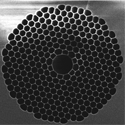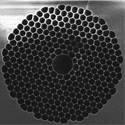Atoms down the tube
The scattering cross section for single photons resonantly interacting with an atom scales with the square of the photon wavelength, which, for resonances near the infrared, exceeds the geometrical size of an atom by eight orders of magnitude. Applications based on interactions between single photons and atoms, such as quantum information processing, can take full advantage of this large resonant cross section only if both light and the atoms are tightly confined.
A team of researchers at the Harvard-MIT Center for Ultracold Atoms has now greatly improved a new and promising technique for achieving this goal. Writing in Physical Review A, Michal Bajcsy and co-workers report on the simultaneous confinement of laser-cooled atoms and light in hollow-core photonic crystal fibers. These fibers, which are already used for nonlinear optical applications, confine the guided light to an empty central region through a photonic-band gap effect. Several years ago the authors already succeeded in trapping a few thousand rubidium atoms in the core of such a fiber and used this system to implement an all-optical switch controlled with less than a thousand photons. They have now increased the number of loaded atoms to 30,000, thus creating a system with great potential for control of light-matter interactions. With this new advance, combining cold atom and crystal fiber technology appears an attractive route toward creating effective atom-mediated interactions between single photons. – Mark Saffman





